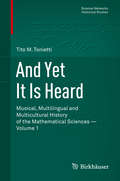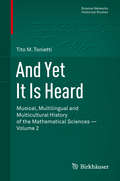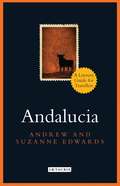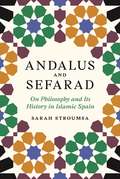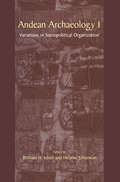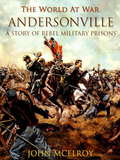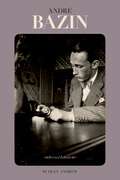- Table View
- List View
And the Weak Suffer What They Must?: Europe, Austerity and the Threat to Global Stability
by Yanis VaroufakisTHE SUNDAY TIMES NUMBER ONE BESTSELLER'If you ever doubt what is at stake in Europe - read Varoufakis's account' GuardianA spectre is haunting Europe – the spectre of failed capitalism. In this startling account of Europe’s economic rise and catastrophic fall, Yanis Varoufakis pinpoints the flaws in the European Union’s design – a design that was thought up after the Second World War, and is responsible for Europe’s fragmentation and the resurgence of racist extremism across the Continent. When the financial crisis struck in 2008, the political elite’s response ensured that it would be the weakest citizens of the weakest nations that would pay the price for the bankers’ mistakes.Drawing on his personal experience of negotiations with the eurozone’s financiers, and offering concrete policies to reform Europe, Varoufakis shows how we concocted this mess, and points the way out of it. And The Weak Suffer What They Must? reminds us of our history, in order to save European capitalism and democracy from the abyss.
And Then She Fell: Number 4 in series (Cynster Sisters #4)
by Stephanie LaurensNo. 1 New York Times bestselling author Stephanie Laurens has returned to another utterly irresistible branch on her beloved Cynster family treeThe only thing more troublesome than a Cynster man is a Cynster lady who believes that love is not her destiny. Famously known in London Society as 'The Matchbreaker', Henrietta Cynster's uncanny skill lies in preventing ill-fated nuptials - not in falling victim to Cupid's alluring spell.However, when she disrupts one match too many, she feels honour-bound to assist the dashing James Glossup and find him a suitable bride for a marriage of convenience.Yet this is no easy task. Complicated by the growing and undeniable attraction that flares between them, Henrietta must convince not only James, but herself, that when it comes to love, she will never, ever fall.
And This is My Friend Sandy: Sandy Wilson's The Boy Friend, London Theatre and Gay Culture
by Deborah PhilipsThis book situates the production of The Boy Friend and the Players' Theatre in the context of a post-war London and reads The Boy Friend, and Wilson's later work, as exercises in contemporary camp. It argues for Wilson as a significant and transitional figure both for musical theatre and for modes of homosexuality in the context of the pre-Wolfenden 1950s.Sandy Wilson's The Boy Friend is one of the most successful British musicals ever written. First produced at the Players' Theatre Club in London in 1953 it transferred to the West End and Broadway, making a star out of Julie Andrews and gave Twiggy a leading role in Ken Russell's 1971 film adaptation. Despite this success, little is known about Wilson, a gay writer working in Britain in the 1950s at a time when homosexuality was illegal.Drawing on original research assembled from the Wilson archives at the Harry Ransom Center, this is the first critical study of Wilson as a key figure of 1950s British theatre. Beginning with the often overlooked context of the Players' Theatre Club through to Wilson's relationship to industry figures such as Binkie Beaumont, Noël Coward and Ivor Novello, this study explores the work in the broader history of Soho gay culture. As well as a critical perspective on The Boy Friend, later works such as Divorce Me, Darling!, The Buccaneer and Valmouth are examined as well as uncompleted musical versions of Pygmalion and Goodbye to Berlin to give a comprehensive and original perspective on one of British theatre's most celebrated yet overlooked talents.
And This is My Friend Sandy: Sandy Wilson's The Boy Friend, London Theatre and Gay Culture
by Deborah PhilipsThis book situates the production of The Boy Friend and the Players' Theatre in the context of a post-war London and reads The Boy Friend, and Wilson's later work, as exercises in contemporary camp. It argues for Wilson as a significant and transitional figure both for musical theatre and for modes of homosexuality in the context of the pre-Wolfenden 1950s.Sandy Wilson's The Boy Friend is one of the most successful British musicals ever written. First produced at the Players' Theatre Club in London in 1953 it transferred to the West End and Broadway, making a star out of Julie Andrews and gave Twiggy a leading role in Ken Russell's 1971 film adaptation. Despite this success, little is known about Wilson, a gay writer working in Britain in the 1950s at a time when homosexuality was illegal.Drawing on original research assembled from the Wilson archives at the Harry Ransom Center, this is the first critical study of Wilson as a key figure of 1950s British theatre. Beginning with the often overlooked context of the Players' Theatre Club through to Wilson's relationship to industry figures such as Binkie Beaumont, Noël Coward and Ivor Novello, this study explores the work in the broader history of Soho gay culture. As well as a critical perspective on The Boy Friend, later works such as Divorce Me, Darling!, The Buccaneer and Valmouth are examined as well as uncompleted musical versions of Pygmalion and Goodbye to Berlin to give a comprehensive and original perspective on one of British theatre's most celebrated yet overlooked talents.
And The World Closed Its Doors: The Story Of One Family Abandoned To The Holocaust
by David Clay LargeMuch has been written about the West's unwillingness to attempt the rescue of tens of thousands of European Jews from the hands of the Nazis. Now David Clay Large gives a specific human face to this tragedy of bureaucratic inertia and ill will. In this masterpiece of Holocaust literature, Large tells the wrenching story of Max Schohl, a German Jew who in the years preceding World War II could not find a government that would allow his family to immigrate, despite wealth, education, business and family connections, a job offer from an American university, and herculean efforts by himself and his American relatives. After repeated but fruitless efforts to gain entry first to the United States, and then to Britain, Chile, and Brazil, Max died in Auschwitz, and his wife and daughters were sent to hard labor in Wiesbaden. Max left behind a unique collection of family letters and documents, which Large has brought together into a gripping, personal commentary on the evolution of the Holocaust in Europe and the hopelessly inadequate response from abroad.
And Yet It Is Heard: Musical, Multilingual and Multicultural History of the Mathematical Sciences - Volume 1 (Science Networks. Historical Studies #46)
by Tito M. ToniettiWe bring into full light some excerpts on musical subjects which were until now scattered throughout the most famous scientific texts. The main scientific and musical cultures outside of Europe are also taken into consideration. The first and most important property to underline in the scientific texts examined here is the language they are written in. This means that our multicultural history of the sciences necessarily also becomes a review of the various dominant languages used in the different historical contexts. In this volume, the history of the development of the sciences is told as it happened in real contexts, not in an alienated ideal world.
And Yet It Is Heard: Musical, Multilingual and Multicultural History of the Mathematical Sciences - Volume 2 (Science Networks. Historical Studies #47)
by Tito M. ToniettiWe bring into full light some excerpts on musical subjects which were until now scattered throughout the most famous scientific texts. The main scientific and musical cultures outside of Europe are also taken into consideration. The first and most important property to underline in the scientific texts examined here is the language they are written in. This means that our multicultural history of the sciences necessarily also becomes a review of the various dominant languages used in the different historical contexts. In this volume, the history of the development of the sciences is told as it happened in real contexts, not in an alienated ideal world.
And Yet They Persisted: How American Women Won the Right to Vote
by Johanna NeumanA comprehensive history of the women’s suffrage movement in the United States, from 1776 to 1965 Most suffrage histories begin in 1848, when Elizabeth Cady Stanton first publicly demanded the right to vote at the Women’s Rights Convention in Seneca Falls, New York. And they end in 1920, when Tennessee became the 36th state to ratify the 19th Amendment, removing sexual barriers to the vote. And Yet They Persisted traces agitation for the vote over two centuries, from the revolutionary era to the civil rights era, excavating one of the greatest struggles for social change in this country and restoring African American women and other women of color to its telling. In this sweeping history, author Johanna Neuman demonstrates that American women defeated the male patriarchy only after they convinced men that it was in their interests to share political power. Reintegrating the long struggle for the women’s suffrage into the metanarrative of U.S. history, Dr. Neuman sheds new light on such questions as: Why it took so long to achieve equal voting rights for women How victories in state suffrage campaigns pressured Congress to act Why African American women had to fight again for their rights in 1965 How the struggle by eight generations of female activists finally succeeded And Yet They Persisted: How American Women Won the Right to Vote his is the ideal text for college courses in women’s studies and history covering the women’s suffrage movement, as well as courses on American History, Political History, Progressive Era reforms, or reform movements in general.Click here to read Johanna Neuman's two-part blog post about the hidden history of Women's Suffrage as we celebrate the centennial anniversary of the 19th Amendment.
And Yet They Persisted: How American Women Won the Right to Vote
by Johanna NeumanA comprehensive history of the women’s suffrage movement in the United States, from 1776 to 1965 Most suffrage histories begin in 1848, when Elizabeth Cady Stanton first publicly demanded the right to vote at the Women’s Rights Convention in Seneca Falls, New York. And they end in 1920, when Tennessee became the 36th state to ratify the 19th Amendment, removing sexual barriers to the vote. And Yet They Persisted traces agitation for the vote over two centuries, from the revolutionary era to the civil rights era, excavating one of the greatest struggles for social change in this country and restoring African American women and other women of color to its telling. In this sweeping history, author Johanna Neuman demonstrates that American women defeated the male patriarchy only after they convinced men that it was in their interests to share political power. Reintegrating the long struggle for the women’s suffrage into the metanarrative of U.S. history, Dr. Neuman sheds new light on such questions as: Why it took so long to achieve equal voting rights for women How victories in state suffrage campaigns pressured Congress to act Why African American women had to fight again for their rights in 1965 How the struggle by eight generations of female activists finally succeeded And Yet They Persisted: How American Women Won the Right to Vote his is the ideal text for college courses in women’s studies and history covering the women’s suffrage movement, as well as courses on American History, Political History, Progressive Era reforms, or reform movements in general.
Andalucia: A Literary Guide for Travellers (Literary Guides for Travellers #7)
by Andrew Edwards Suzanne EdwardsAndalucia is the quintessence of Spain and yet, historically and culturally, it is surprisingly unlike the rest of the country. Its literary history began to develop with the Romans and reached an early flowering when Arabic poets drew on centuries of literary tradition, together with the landscapes and passions of Moorish Spain. Later, Prosper Mérimée, Byron and Washington Irving forged legends of exotic southern Spain that persist to this day and Spanish writers themselves captured the rich tapestry of Andalucian culture, from Cervantes' Seville to the Córdoba of Baroque poet Luis de Góngora and Lorca's 'hidden Andalucia'. With the advent of the Civil War, a new generation flocked to Andalucia and were inspired to write some of the Twentieth Century's most iconic works of literature, from Hemingway's For Whom the Bell Tolls to Gerald Brenan's The Spanish Labyrinth and Laurie Lee's trilogy of books. As vibrant and compelling as the region itself, Andalucia: A Literary Guide for Travellers illuminates the very soul of Spain.
Andalus and Sefarad: On Philosophy and Its History in Islamic Spain (Jews, Christians, and Muslims from the Ancient to the Modern World #62)
by Sarah StroumsaAn integrative approach to Jewish and Muslim philosophy in al-AndalusAl-Andalus, the Iberian territory ruled by Islam from the eighth to the fifteenth centuries, was home to a flourishing philosophical culture among Muslims and the Jews who lived in their midst. Andalusians spoke proudly of the region's excellence, and indeed it engendered celebrated thinkers such as Maimonides and Averroes. Sarah Stroumsa offers an integrative new approach to Jewish and Muslim philosophy in al-Andalus, where the cultural commonality of the Islamicate world allowed scholars from diverse religious backgrounds to engage in the same philosophical pursuits.Stroumsa traces the development of philosophy in Muslim Iberia from its introduction to the region to the diverse forms it took over time, from Aristotelianism and Neoplatonism to rational theology and mystical philosophy. She sheds light on the way the politics of the day, including the struggles with the Christians to the north of the peninsula and the Fāṭimids in North Africa, influenced philosophy in al-Andalus yet affected its development among the two religious communities in different ways.While acknowledging the dissimilar social status of Muslims and members of the religious minorities, Andalus and Sefarad highlights the common ground that united philosophers, providing new perspective on the development of philosophy in Islamic Spain.
Andalus and Sefarad: On Philosophy and Its History in Islamic Spain (Jews, Christians, and Muslims from the Ancient to the Modern World #62)
by Sarah StroumsaAn integrative approach to Jewish and Muslim philosophy in al-AndalusAl-Andalus, the Iberian territory ruled by Islam from the eighth to the fifteenth centuries, was home to a flourishing philosophical culture among Muslims and the Jews who lived in their midst. Andalusians spoke proudly of the region's excellence, and indeed it engendered celebrated thinkers such as Maimonides and Averroes. Sarah Stroumsa offers an integrative new approach to Jewish and Muslim philosophy in al-Andalus, where the cultural commonality of the Islamicate world allowed scholars from diverse religious backgrounds to engage in the same philosophical pursuits.Stroumsa traces the development of philosophy in Muslim Iberia from its introduction to the region to the diverse forms it took over time, from Aristotelianism and Neoplatonism to rational theology and mystical philosophy. She sheds light on the way the politics of the day, including the struggles with the Christians to the north of the peninsula and the Fāṭimids in North Africa, influenced philosophy in al-Andalus yet affected its development among the two religious communities in different ways.While acknowledging the dissimilar social status of Muslims and members of the religious minorities, Andalus and Sefarad highlights the common ground that united philosophers, providing new perspective on the development of philosophy in Islamic Spain.
Andean Archaeology I: Variations in Sociopolitical Organization
by William H. Isbell Helaine SilvermanStudy of the origin and development of civilization is of unequaled importance for understanding the cultural processes that create human societies. Is cultural evolution directional and regular across human societies and history, or is it opportunistic and capricious? Do apparent regularities come from the way inves tigators construct and manage knowledge, or are they the result of real constraints on and variations in the actual processes? Can such questions even be answered? We believe so, but not easily. By comparing evolutionary sequences from different world civilizations scholars can judge degrees of similarity and difference and then attempt explanation. Of course, we must be careful to assess the influence that societies of the ancient world had on one another (the issue of pristine versus non-pristine cultural devel opment: see discussion in Fried 1967; Price 1978). The Central Andes were the locus of the only societies to achieve pristine civilization in the southern hemi sphere and only in the Central Andes did non-literate (non-written language) civ ilization develop. It seems clear that Central Andean civilization was independent on any graph of archaic culture change. Scholars have often expressed appreciation of the research opportunities offered by the Central Andes as a testing ground for the study of cultural evolu tion (see, e. g. , Carneiro 1970; Ford and Willey 1949: 5; Kosok 1965: 1-14; Lanning 1967: 2-5).
Andean Archaeology III: North and South
by Helaine Silverman William IsbellThe third volume in the Andean Archaeology series, this book focuses on the marked cultural differences between the northern and southern regions of the Central Andes, and considers the conditions under which these differences evolved, grew pronounced, and diminished. This book continues the dynamic, current problem-oriented approach to the field of Andean Archaeology that began with Andean Archaeology I and Andean Archaeology II. Combines up-to-date research, diverse theoretical platforms, and far-reaching interpretations to draw provocative and thoughtful conclusions.
Andean Foodways: Pre-Columbian, Colonial, and Contemporary Food and Culture (The Latin American Studies Book Series)
by John E. StallerThere is widespread acknowledgement among anthropologists, archaeologists, ethnobotanists, as well as researchers in related disciplines that specific foods and cuisines are linked very strongly to the formation and maintenance of cultural identity and ethnicity. Strong associations of foodways with culture are particularly characteristic of South American Andean cultures. Food and drink convey complex social and cultural meanings that can provide insights into regional interactions, social complexity, cultural hybridization, and ethnogenesis. This edited volume presents novel and creative anthropological, archaeological, historical, and iconographic research on Andean food and culture from diverse temporal periods and spatial settings. The breadth and scope of the contributions provides original insights into a diversity of topics, such as the role of food in Andean political economies, the transformation of foodways and cuisines through time, and ancient iconographic representations of plants and animals that were used as food. Thus, this volume is distinguished from most of the published literature in that specific foods, cuisines, and culinary practices are the primary subject matter through which aspects of Andean culture are interpreted.
Andean Truths: Transitional Justice, Ethnicity, and Cultural Production in Post-Shining Path Peru (Liverpool Latin American Studies #14)
by Anne LambrightAndean Truths: Transitional Justice, Ethnicity, and Cultural Production in Post-Shining Path Peru studies how literature, drama, film, and the visual arts contest the dominant narrative of national peace and reconciliation, as constructed by Peru’s Truth and Reconciliation Commission. Established in 2001, the Commission aimed to ‘investigate and make public the truth’ of the country’s twenty-year civil war, drawing upon homologous predecessors that provided a highly scripted model of truth-gathering and national healing. In this model, a predetermined collective mourning, catharsis, and reconciliation would move the nation forward in a consensually-determined fashion. Andean Truths shows that the Peruvian case proves internationally-endorsed models insufficient for arriving at the ‘truth’ of a national trauma that primarily affected disenfranchised ethnic groups, namely, the Andean Quechua speaking populations that accounted for the overwhelming majority of victims of the violence. Even as scholars recognize the importance of bringing multiple voices to the table in discussing post-Shining Path Peru, we are still trying to understand what a more Andean-oriented transitional justice process might entail. Drawing on theories of decoloniality, intercultural communication and epistemological diversity (following scholars such as Enrique Dussel, Aníbal Quijano and Boaventura de Sousa Santos), Lambright analyzes cultural products, from the theater of Yuyachkani to the narrative of Oscar Colchado Lucio, the art of Edilberto Jiménez, and other popular artistic responses, that highlight Andean understandings of the conflict and its aftermath. These cultural products challenge dominant understandings of the conflict and question Peru’s ability to overcome its collective trauma without seriously reconsidering prevailing cultural paradigms.Andean Truths was awarded the 2015 Modern Language Association’s Katherine Singer Kovacs Prize for Outstanding Book on Latin America or Spain.
Andere anatomische Anekdoten
by Helmut WichtDer Autor ist ein Anatom, dem so mancherlei durch den Kopf geht, und eh' er es vergisst, schreibt er's auf. Oft sind es melancholische Gedanken, manchmal garstige, und manchmal welche, die er erheiternd findet. Versuchen Sie, die Geschichten als "Miniaturen" zu lesen. Filigrane, oft ein wenig umständliche und versponnene Spielereien über ein Thema, einen Gedanken, eine Beobachtung, ein Wort. Stimmungsbilder. Nehmen Sie das Büchlein nicht allzu ernst - das ist kein Sachbuch, kein Pamphlet, der Autor hat kein Anliegen, hat nicht die Absicht, Sie zu lehren. Er will Sie unterhalten, vielleicht hie und da verwundern und Ihnen die Anatomie als etwas näherbringen, was sie auch ist: ein ästhetisches, ein sprachverliebtes Fach. Nehmen Sie es doch ernst - was hier drinnen steht, ist wahr. Wahr in dem Sinne, dass die anatomischen und sonstigen wissenschaftlichen Sachverhalte, von denen die Rede sein wird, bis ins Detail so sind, wie sie beschrieben werden; wahr in dem Sinne, dass die Ereignisse, die geschildert werden, sich wirklich so ähnlich ereignet haben.
Andersmöglichsein. Zur Ästhetik des Designs (Design #41)
by Annette GeigerWovon wollen wir sprechen, wenn wir über Design nachdenken? Wer um sich blickt, trifft unweigerlich auf geformte Dinge. Man hat sie entworfen, um sie nutzbar zu machen. Aber ist alles, was man benutzen kann, schon Design? Unsere Gesellschaft hat den Design-Begriff hervorgebracht, um anhand bestimmter Kriterien das Gestaltete von anderem zu unterscheiden. Diese Codierungen können als Form der ästhetischen Wahrnehmung begriffen werden. Annette Geiger bietet einen Überblick zur Theorie und Geschichte der Gestaltung für alle, die der Disziplin in neuer Perspektive begegnen wollen: Design ist das Ausloten von Andersmöglichsein.
Andersonville A Story of Rebel Military Prisons (The World At War)
by John McElroyThis is the story of Andersonville. Considered one of the most horrific prisons in the Civil War
André Bazin
by Dudley AndrewAndré Bazin, often dubbed the father of the French New Wave, has had an immense impact on film art. He is credited with almost single-handedly establishing the study of film as an accepted intellectual pursuit. The journal that he founded in 1951, Cahiers du Cinéma, remains the most influential archive of cinema criticism. He remains one of the most read, most studied, and most engaging figures ever to have written about film. The last few years have witnessed a massive resurgence of interest in Bazin among critics, scholars, and students of every persuasion. His writings, a mainstay of film theory courses, are now finding a place on the syllabi of core courses in film history, criticism, and appreciation. Andrew's intellectual biography is a landmark in film scholarship.
André Bazin
by Dudley AndrewAndré Bazin, often dubbed the father of the French New Wave, has had an immense impact on film art. He is credited with almost single-handedly establishing the study of film as an accepted intellectual pursuit. The journal that he founded in 1951, Cahiers du Cinéma, remains the most influential archive of cinema criticism. He remains one of the most read, most studied, and most engaging figures ever to have written about film. The last few years have witnessed a massive resurgence of interest in Bazin among critics, scholars, and students of every persuasion. His writings, a mainstay of film theory courses, are now finding a place on the syllabi of core courses in film history, criticism, and appreciation. Andrew's intellectual biography is a landmark in film scholarship.





